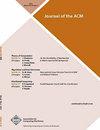Exponentially Faster Massively Parallel Maximal Matching
IF 2.5
2区 计算机科学
Q2 COMPUTER SCIENCE, HARDWARE & ARCHITECTURE
引用次数: 2
Abstract
The study of approximate matching in the Massively Parallel Computations (MPC) model has recently seen a burst of breakthroughs. Despite this progress, we still have a limited understanding of maximal matching which is one of the central problems of parallel and distributed computing. All known MPC algorithms for maximal matching either take polylogarithmic time which is considered inefficient, or require a strictly super-linear space of n 1+Ω (1) per machine. In this work, we close this gap by providing a novel analysis of an extremely simple algorithm, which is a variant of an algorithm conjectured to work by Czumaj, Lacki, Madry, Mitrovic, Onak, and Sankowski [ 15 ]. The algorithm edge-samples the graph, randomly partitions the vertices, and finds a random greedy maximal matching within each partition. We show that this algorithm drastically reduces the vertex degrees. This, among other results, leads to an O (log log Δ) round algorithm for maximal matching with O(n) space (or even mildly sublinear in n using standard techniques). As an immediate corollary, we get a 2 approximate minimum vertex cover in essentially the same rounds and space, which is the optimal approximation factor under standard assumptions. We also get an improved O (log log Δ) round algorithm for 1 + ε approximate matching. All these results can also be implemented in the congested clique model in the same number of rounds.指数更快的大规模并行最大匹配
大规模并行计算(MPC)模型中近似匹配的研究近年来取得了突破性进展。尽管取得了这些进展,但我们对最大匹配的理解仍然有限,最大匹配是并行和分布式计算的核心问题之一。所有已知的最大匹配MPC算法要么需要多对数时间,这被认为是低效的,要么需要每台机器n 1+Ω(1)的严格超线性空间。在这项工作中,我们通过对一种极其简单的算法进行新颖的分析来缩小这一差距,该算法是Czumaj、Lacki、Madry、Mitrovic、Onak和Sankowski[15]推测有效的算法的变体。该算法对图进行边采样,对顶点进行随机分区,并在每个分区内找到一个随机贪婪的最大匹配。我们证明了该算法极大地减少了顶点度。在其他结果中,这导致了O(log log Δ)轮算法与O(n)空间的最大匹配(或者使用标准技术在n中甚至轻度次线性)。作为一个直接的推论,我们在本质上相同的回合和空间中得到了2个近似的最小顶点覆盖,这是标准假设下的最佳近似因子。我们还得到了一种改进的0 (log log Δ)轮算法用于1 + ε近似匹配。所有这些结果也可以在相同轮数的拥塞团模型中实现。
本文章由计算机程序翻译,如有差异,请以英文原文为准。
求助全文
约1分钟内获得全文
求助全文
来源期刊

Journal of the ACM
工程技术-计算机:理论方法
CiteScore
7.50
自引率
0.00%
发文量
51
审稿时长
3 months
期刊介绍:
The best indicator of the scope of the journal is provided by the areas covered by its Editorial Board. These areas change from time to time, as the field evolves. The following areas are currently covered by a member of the Editorial Board: Algorithms and Combinatorial Optimization; Algorithms and Data Structures; Algorithms, Combinatorial Optimization, and Games; Artificial Intelligence; Complexity Theory; Computational Biology; Computational Geometry; Computer Graphics and Computer Vision; Computer-Aided Verification; Cryptography and Security; Cyber-Physical, Embedded, and Real-Time Systems; Database Systems and Theory; Distributed Computing; Economics and Computation; Information Theory; Logic and Computation; Logic, Algorithms, and Complexity; Machine Learning and Computational Learning Theory; Networking; Parallel Computing and Architecture; Programming Languages; Quantum Computing; Randomized Algorithms and Probabilistic Analysis of Algorithms; Scientific Computing and High Performance Computing; Software Engineering; Web Algorithms and Data Mining
 求助内容:
求助内容: 应助结果提醒方式:
应助结果提醒方式:


